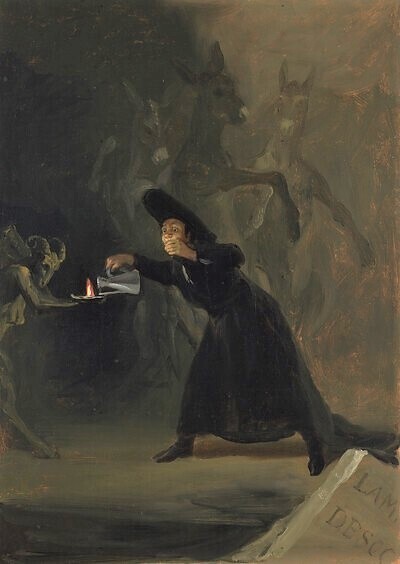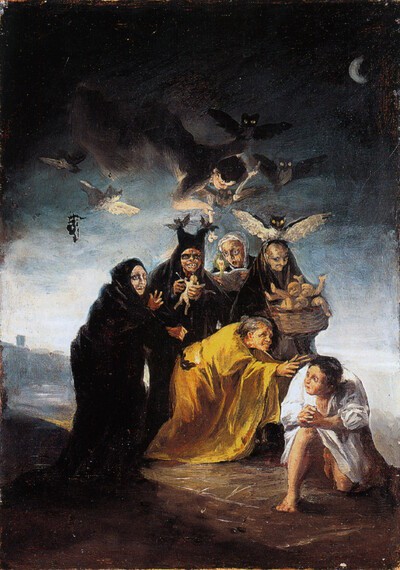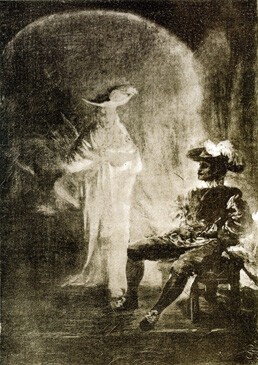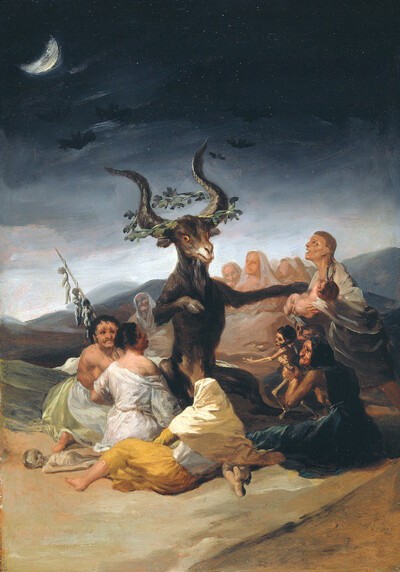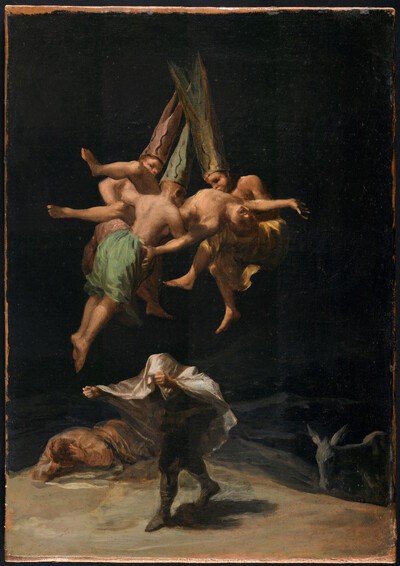- Cronología
- 1798
- Ubicación
- The National Gallery, London, United Kingdom
- Dimensiones
- 42.5 x 30.8 cm
- Técnica y soporte
- Oil on canvas
- Reconocimiento de la autoría de Goya
- Undisputed work
- Titular
- The Trustees of the National Gallery
- Ficha: realización/revisión
- 10 May 2010 / 15 Jun 2023
- Inventario
- (1472)
- Otros títulos:
-
The Forcibly Bewitched
The Forcibly Bewitched
The Devil’s Lamp
This work was purchased by the National Gallery in London in 1896.
The painting is based on a scene from Act II of the comedy The Forcibly Bewitched (El hechizado por fuerza), by Antonio de Zamora (Madrid, 1665-Ocaña, 1727), a very popular play in Goya's day. It was performed in Madrid around the same time as Goya was painting this series of works for the Duke and Duchess of Osuna, who were themselves enthusiastic theatre-goers and would have known Zamora's play well. According to Frank Irving, it may have been Moratín who recommended that Goya paint this particular scene, in the course of one of the literary gatherings which both men regularly attended at the home of the aristocrats who commissioned these paintings.
The picture shows the figure of Don Claudio, an Asturian cleric who believed himself to have been bewitched and who thought that his life depended on keeping an oil lamp burning, the same lamp held here by the devil in the form of a he-goat. Whilst he refills the lamp with oil he prays that the evil spell not come true. In the book shown in the extreme foreground we can read the fragments "LAM/DESCO" (from "Lámpara descomunal", or "Monstrous lamp"), in reference to the first two words of the monologue that the character of Don Claudio addresses to the lamp: "Monstrous lamp / whose vile reflection / just like a wick / sucks up my life's oil / ...".
At the back of the composition, three donkeys, painted with loose brushstrokes, are standing up on their hind legs and dancing. They represent the moment in the play when Don Claudio, walking across the room, says: "A dance here can be / seen, although not very well, / Of donkeys; I know who / Could join this dance".
With this work, Goya was commenting on how an unbalanced mind can end up turning fantasy into reality, and vice versa, and in this way brings to mind the content of his Caprices series of etchings.
For more information, see The Witches' Flight.
-
Goya y el espíritu de la IlustraciónMuseo Nacional del PradoMadrid1988from October 6th to December 18th 1988. Exhibited also at Museum of Fine Arts, Boston, January 18th to March 26th 1989; The Metropolitan Museum of Art, Nueva York, May 9th to July 16th 1989, Madrid curator Manuela B. Mena Marqués, scientific directors Alfonso E. Pérez Sánchez and Eleanor A. Sayrepp. 58-60, cat. 25
-
Goya. El Capricho y la Invención. Cuadros de gabinete, bocetos y miniaturasMuseo Nacional del PradoMadrid1993from November 18th 1993 to February 15th 1994. Exhibited also at the Royal Academy of Arts, London, March 18th to June 12th 1994 and The Art Institute of Chicago, Chicago, July 16th to October 16th 1994, consultant editors Manuela B. Mena Marqués and Juliet Wilson-Bareaucat. 49
-
Francisco de Goya: Maleri, Tegning, GrafikkNasjonalgallerietOslo1996from 10th to April 14th 1996cat. 15
-
Goya: Prophet der ModerneAlte NationalgalerieBerlin2005from July 13th to October 3th 2005. Exhibitied also at the Kunsthistorischemuseum, Vienna, October 18th 2005 to January 8th 2006, consultant editor Manuela B. Mena Marquéscat. 66
-
Goya en tiempos de guerraMuseo Nacional del PradoMadrid2008consultant editor Manuela B. Mena Marqués, from April 14th to July 13th 2008cat. 16
-
GoyaBasle2021p. 152
-
L'œuvre peint de Goya. 4 volsParís1928-1950p. 212, cat. 174
-
Goya, Saturno y melancolía. Consideraciones sobre el arte de GoyaStockholmAlquimis & Wiksell1962pp. 154-158
-
Vie et ouvre de Francisco de GoyaParísOffice du livre1970p. 188, cat. 663
-
BarcelonaPolígrafa1970vol. I, p. 296, cat. 359
-
L’opera pittorica completa di GoyaMilanRizzoli1974p. 111, cat. 343
-
Francisco de Goya, 4 vols.ZaragozaCaja de Ahorros de Zaragoza, Aragón y Rioja1980-1982vol. III, p. 106
-
Goya. Arte e condizione umanaNaplesLiguori editore1990il. 84
-
Goya. El capricho y la invención. Cuadros de gabinete, bocetos y miniaturasMadridMuseo del Prado1993pp. 211, 212, 213, 214, 215 y 221 (il.),
-
Goya y la locuraZaragoza2000pp. 20, 21, 22, 23, 24, 25 y 26.
-
Goya y sus seis asuntos de brujasGoyaMadrid2003pp. 197-214
